Wrist wraps have become an essential accessory for weightlifters and strength training enthusiasts looking to enhance their performance and protect their wrists from injury. Whether you’re a beginner just starting to lift or a seasoned athlete aiming to push your limits, wrist wraps can provide the stability and support necessary to safely handle heavier weights. This comprehensive guide will walk you through everything you need to know about wrist wraps, from their benefits and types to how to use them correctly and choose the best ones for your training needs. By the end of this guide, you’ll understand how wrist wraps can be a game-changer in your lifting routine, helping you lift more confidently and safely.
Table of Contents
What are Wrist Wraps?
Wrist wraps are supportive bands designed to be worn around the wrists during weightlifting and other strength training activities. Their primary purpose is to stabilize the wrist joint, providing extra support and reducing the risk of injury during heavy lifts. By keeping the wrist in a firm, neutral position, they help prevent excessive movement or strain that could lead to pain or damage over time.
Typically, these bands are made from durable materials like cotton, nylon, or a blend of elastic fibres. This combination allows for flexibility, breathability, and a snug fit. Wrist wraps come in various lengths, commonly ranging from 12 to 36 inches, which allows athletes to choose the level of support they need. They are also equipped with a Velcro closure, making them easy to adjust for comfort and secure tightly in place.

It’s important not to confuse wrist wraps with wrist straps, as they serve different purposes. Wrist wraps are specifically designed for wrist support and stability. In contrast, wrist straps are intended to assist with grip strength, often used in exercises like deadlifts, where the lifter’s grip might fail before their muscles do. Knowing the distinction between these two accessories can help lifters choose the right tool for their training needs.
What are the Benefits of Wrist Wraps?
| Wrist support bands offer several key advantages to those engaging in weightlifting and strength training. One of their primary benefits is providing crucial support and stability to the wrist joint. By keeping the wrists in a secure position, these bands help prevent hyperextension, a common issue when lifting heavy weights that can lead to significant strain and discomfort. |
Other Benefits of Wrist Wraps Are:
Enhanced performance: When the wrists are properly supported, lifters can maintain better alignment and control during exercises. This stability allows for more efficient force transfer from the body to the weights, enabling athletes to lift heavier loads and perform more reps. Whether it’s bench pressing, overhead pressing, or squats, proper wrist support can make a noticeable difference in performance and confidence.
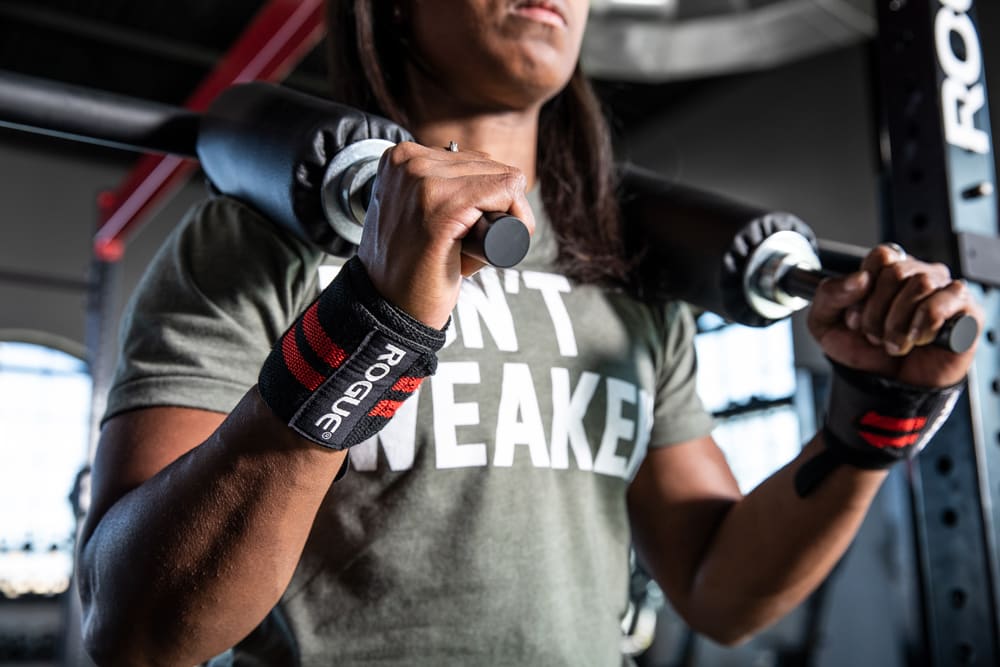
Injury prevention: Lifting heavy weights places immense stress on the wrist joints, making them susceptible to injuries such as sprains, strains, or even more severe damage. By providing added reinforcement, these bands help distribute the load more evenly across the wrist, reducing the risk of injury and promoting long-term joint health.
pain relief: particularly for individuals who already suffer from wrist issues or arthritis. By limiting excessive movement and providing a cushion against strain, they can help alleviate pain and discomfort during lifts, making training sessions more comfortable and productive. This pain relief is especially beneficial for older athletes or those with pre-existing conditions that make their wrists more vulnerable to stress.
Different Types of Wrist Wraps
| When choosing the right wrist support for your weightlifting needs, it’s essential to understand the different types available. Each type serves a unique purpose and offers varying levels of support, flexibility, and comfort. |
Lightweight Wrist Supports: These wrist wraps are perfect for beginners or those engaging in lighter workouts. They are typically more flexible, allowing for a greater range of motion while still providing enough stability to protect the wrists. Lightweight options are comfortable and less restrictive, making them suitable for general fitness routines and everyday use.
Heavy-Duty Bands: For those involved in powerlifting or heavy weightlifting, heavy-duty wrist wraps are the go-to choice. These are designed to offer maximum support, ensuring the wrist joints remain stable under substantial loads. The robust nature of these bands makes them ideal for lifters pushing their limits and aiming to handle heavier weights safely.
Stiff Wrist Supports: Advanced lifters who focus on lifting the maximum weight might prefer stiff options. Stiff wrist wraps provide less flexibility but offer unparalleled support, crucial for maintaining wrist alignment during heavy lifts. The reduced movement helps lifters generate more power, making stiff wraps a popular choice for competitive lifters and those aiming for personal records.
Length Variations: Wrist support bands come in various lengths, typically ranging from 12 to 36 inches. Shorter options, around 12-18 inches, are easier to put on and take off, making them convenient for quick workouts. However, they offer less support compared to their longer counterparts. On the other hand, longer wrist wraps, 24-36 inches, provide enhanced stability and are better suited for heavy lifting sessions. The extra length allows for more wraps around the wrist, increasing the level of support.
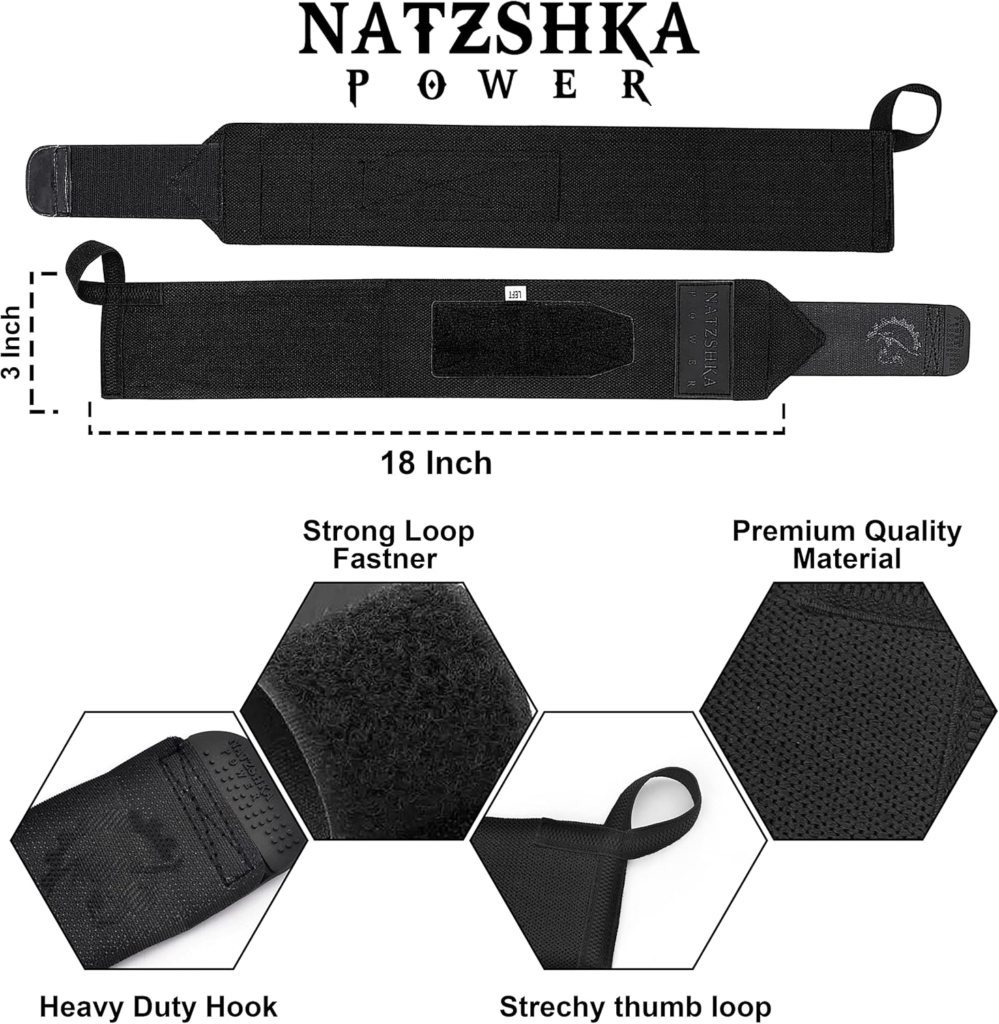
Material Considerations: The choice of material can significantly affect the comfort and effectiveness of wrist wraps. Common materials include cotton, which is breathable and comfortable against the skin, and elastic blends that provide a snug fit and excellent support. Some wrist wraps incorporate a mix of these materials to balance flexibility and durability. The material choice can also impact how well the wraps stay in place during a workout and how they feel against the skin, making it important to choose based on personal preference and training needs.
Learn about all the different types of wrist wraps and how to use there here
How to Use Wrist Wraps
Using wrist wraps correctly can significantly enhance your lifting experience, providing the stability and protection needed to push your limits safely. Here’s a step-by-step guide on how to effectively use them during various exercises:
- Positioning the Wrap: Start by placing the band around your wrist, ensuring that it sits just above the wrist joint. This position allows for optimal support without restricting hand movement. Most wraps come with a thumb loop to hold them in place while wrapping; use this loop to secure the band as you begin.
- Wrapping Technique: Begin wrapping the band around your wrist, starting from the base of your palm and working your way down towards your forearm. Each wrap should overlap slightly to create a uniform layer of support. Make sure to wrap tightly enough to provide stability, but not so tight that it cuts off circulation. The goal is to maintain a balance between support and comfort.
- Securing the Wrap: Once you’ve wrapped the band around your wrist to the desired tightness, use the Velcro closure to secure it in place. Ensure the Velcro is firmly attached so the wrap doesn’t come loose during your workout. You can adjust the tightness by pulling the wrap more or less before securing it, depending on the level of support needed for specific exercises.
- Using During Exercises: When performing exercises like the bench press, overhead press, or squats, the wrist supports should be snug enough to prevent your wrists from bending backwards under the weight. For movements that require more wrist flexibility, such as some Olympic lifts or gymnastic exercises, you might opt for a slightly looser wrap to allow more range of motion.
- Adjusting Tightness: It’s crucial to adjust the tightness of the wraps according to the exercise you’re performing. Over-tightening can lead to restricted blood flow, numbness, or even reduced grip strength. Loosen the wraps between sets or exercises to allow circulation to return to normal, especially during longer training sessions.
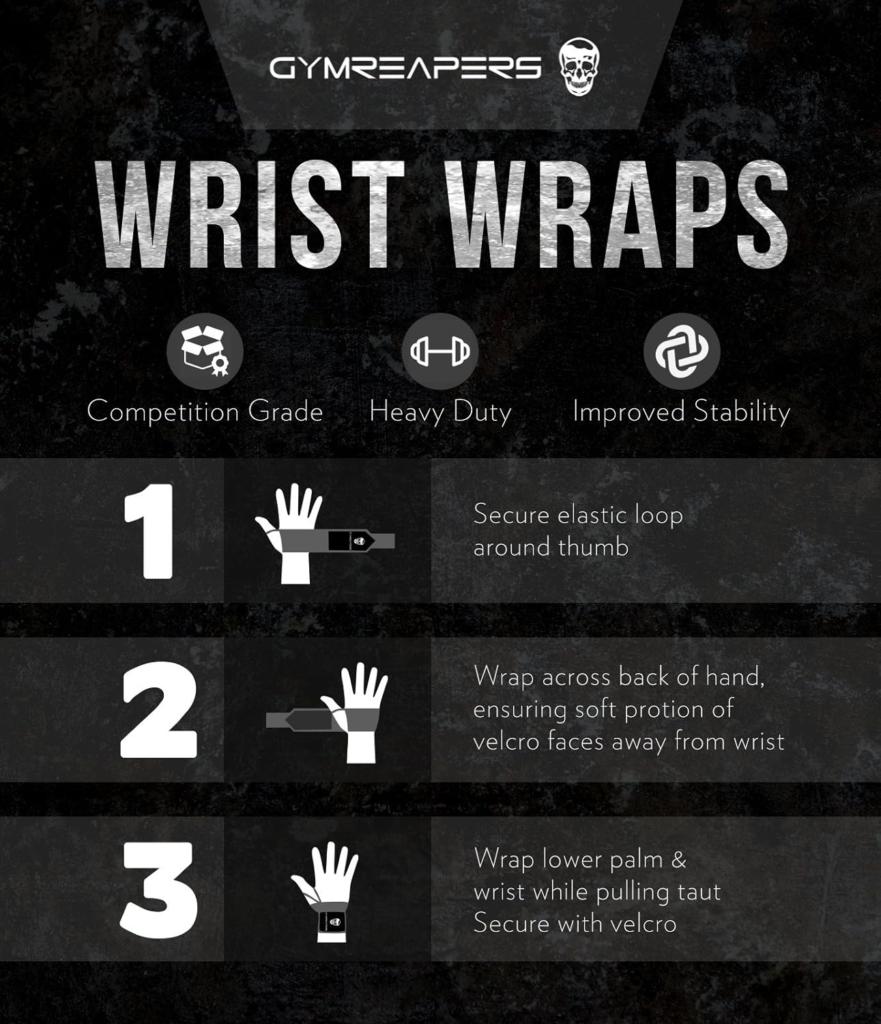
| Common Mistakes to Avoid –Over-tightening: One of the most common mistakes is making the wrist wraps too tight. While it’s important to provide adequate support, wraps that are too tight can cause discomfort, reduce blood flow, and even lead to numbness in the hands. Aim for a snug fit that supports without constricting. -Incorrect Positioning: Placing the wraps too high or too low can reduce their effectiveness. Ensure they are positioned just above the wrist joint for maximum support and to prevent hyperextension. –Using for the Wrong Exercises: Wrist support bands are not necessary for every exercise. Avoid using them during movements where wrist flexibility is crucial or where they may interfere with the natural range of motion, as this can lead to improper technique or increased injury risk. |
How to Put on Wrist Wraps
Properly putting on wrist support bands is essential to maximize their benefits and ensure comfort during your workout. Follow these detailed steps to ensure your wrists are well-protected and supported:
| 1.Start with the Thumb Loop: Begin by placing your thumb through the loop provided on one end of the band. This loop acts as an anchor, keeping the band in place while you wrap it around your wrist. Make sure the rest of the band is hanging loosely, ready to be wrapped. 2.Position the Band Correctly: With the thumb loop in place, position the band so it starts just above the wrist joint. This placement allows the band to provide support where it’s most needed—right at the base of your palm. Ensuring the wrap sits in this position helps protect the wrist from bending too far backward during lifts. 3.Wrap Around the Wrist: Begin wrapping the band around your wrist, moving in a circular motion. Each time you pass the band around, make sure to overlap it slightly with the previous layer. This overlapping provides even support across the wrist. As you wrap, pull the band snug to ensure a firm fit, but avoid wrapping so tightly that it cuts off circulation or causes discomfort. 4.Continue Wrapping: Depending on the length of the band, you may wrap it around your wrist several times. The number of wraps will depend on how much support you need and the specific length of the band you’re using. For heavier lifts, you might prefer additional layers for extra stability. 5.Secure with Velcro: Once you’ve wrapped the band around your wrist the desired number of times, use the Velcro closure to secure it in place. Fasten the Velcro tightly enough that the band won’t slip or move during your workout, but again, ensure it’s not so tight that it restricts blood flow or movement. The wrap should feel secure and provide a firm base of support. 6.Check the Fit: After securing the Velcro, move your wrist slightly to check the fit. You should feel a good amount of support without experiencing any discomfort or numbness. If the wrap feels too tight or too loose, adjust it accordingly. It’s important to find the right balance between support and comfort to avoid any distractions during your workout. 7.Adjust as Needed: If you’re performing different exercises or transitioning between sets, you might need to adjust the tightness of the wrap. Loosen or tighten it based on the level of support required for each specific movement. Some exercises may demand more wrist flexibility, while others require maximum stability. 8.Visuals and Tutorials: To get a better understanding of how to put on wrist wraps, consider watching video tutorials or looking at instructional visuals. Many fitness experts and brands provide step-by-step guides online that can be extremely helpful for visual learners. Seeing the process in action can clarify any doubts and ensure you’re using the wraps correctly. |
Learn how to correctly put on your wrist wraps here
Best Wrist Wraps of 2024
Finding the right wrist support can make a significant difference in your lifting performance and overall comfort during workouts. Here’s a roundup of some of the best options available in 2024, tailored to different needs and preferences.
Top Picks for Beginners: Affordable and Flexible Options
For those new to weightlifting or looking for everyday gym support, lightweight and flexible wraps are the way to go. These options are typically more affordable and provide just enough support without being too restrictive. Look for brands that offer adjustable wraps with a good balance of elasticity and comfort. Popular picks include the Harbinger Red Line Wraps and Rip Toned Wrist Supports, both known for their affordability and ease of use. These models are perfect for beginners who want to get accustomed to using wraps without investing in heavier-duty options.
Best for Powerlifters: Heavy-Duty, Stiff Wraps for Maximum Support
Powerlifters and serious strength trainers often need heavy-duty wraps that provide the utmost support and stability. These wraps are designed to handle the pressure of lifting maximum weights, offering a stiff feel that ensures the wrists stay firmly in place. Rogue Fitness Wrist Bands and Titan Signature Gold Wraps are among the top choices in this category. Known for their durability and strength, these bands provide the rigid support necessary for heavy bench presses, squats, and other high-stress exercises. They are built to last, making them a smart investment for anyone lifting at advanced levels.

Most Comfortable: Wraps that Offer a Balance Between Support and Comfort
For lifters who prioritize comfort without sacrificing support, finding the right balance is key. Some wraps are designed to provide enough stability while still allowing some movement, making them ideal for longer workouts or high-repetition sets. The Iron Bull Strength Wraps and Stoic Wrist Wraps are standout options in this category. These wraps use high-quality materials that offer a softer feel against the skin, combined with enough elasticity to ensure comfort during extended use. They are perfect for those who need to wear them throughout an entire workout session without experiencing discomfort.
Best Overall: Criteria for Selecting the Best Wraps
When selecting the best overall wrist support, several factors come into play, including durability, comfort, support, and price. A top-notch wrap should be made from high-quality materials that withstand wear and tear, offer a comfortable fit, and provide ample support for various lifting activities. Bear KompleX Wraps and Gymreapers Wrist Supports have emerged as leaders in the market, combining durability and comfort with excellent support. They are versatile enough for both casual gym-goers and serious lifters, making them a great all-around choice.
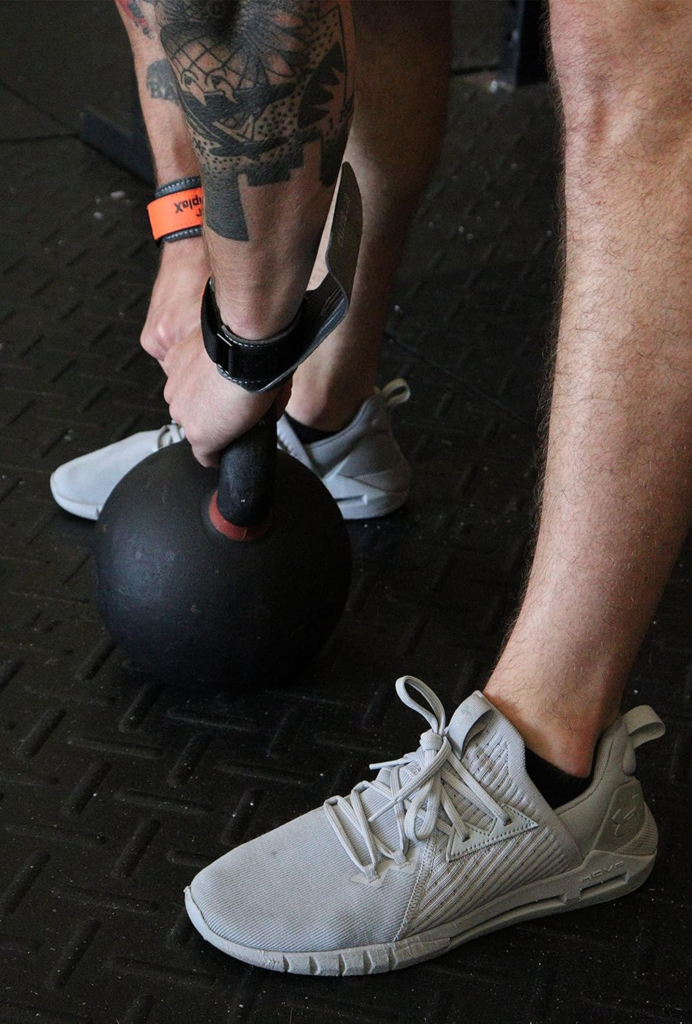
Why These Brands Stand Out
- Harbinger Red Line Wraps: Known for their affordability and flexibility, making them accessible to beginners.
- Rip Toned Wrist Supports: Offers a good blend of support and elasticity, ideal for those new to using wrist wraps.
- Rogue Fitness Wrist Bands: Highly durable and stiff, catering to powerlifters who need maximum stability.
- Titan Signature Gold Wraps: Recognized for their rigidity and support, suitable for lifting heavy weights.
- Iron Bull Strength Wraps: Focus on comfort and flexibility, making them great for extended use.
- Stoic Wrist Wraps: Combine comfort with support, perfect for high-rep workouts.
- Bear KompleX Wraps: Versatile, durable, and comfortable, making them suitable for various lifting needs.
- Gymreapers Wrist Supports: Offer excellent all-around performance with high-quality construction and support.
Pros and Cons of Using Wrist Wraps
While wrist support bands can be a valuable tool for many lifters, it’s important to weigh their advantages against some potential drawbacks. Understanding both sides will help you make an informed decision about incorporating them into your routine.
| Pros: 1.Increased Wrist Stability and Support: One of the primary benefits of these support bands is the added stability they provide to the wrist joint. By keeping the wrist in a more secure and neutral position, these bands can prevent excessive bending or movement, which is especially beneficial during heavy lifting. This stability is crucial for maintaining proper form and technique, which can enhance overall performance and safety. 2.Enhanced Lifting Performance: With the added support from wrist bands, lifters often find they can push themselves harder and lift heavier weights. By providing a solid base for the wrist, these bands help transfer power more efficiently from the arms to the weights, improving lifting capacity. This can be a significant advantage when trying to break personal records or progress in strength training. 3.Reduction in Wrist Pain and Injury Risk: For individuals prone to wrist pain or those recovering from minor injuries, wrist bands can offer much-needed relief. They help distribute the load more evenly across the wrist, reducing stress on the joint and minimizing the risk of injuries such as sprains and strains. This protective aspect makes them a valuable accessory for preventing both acute and chronic wrist issues. | Cons: 1.Potential Over-Reliance Can Weaken Wrist Strength: One downside to using these bands regularly is the potential for over-reliance. If used too frequently, the muscles and tendons in the wrist might not develop the strength and resilience they need. Relying too much on external support can lead to weaker wrists over time, which might affect performance when lifting without the bands. 2.Incorrect Usage May Lead to Circulation Issues: If not used correctly, these bands can cause circulation problems. Wrapping them too tightly can restrict blood flow, leading to numbness, tingling, or even pain in the hands and fingers. It’s important to find the right balance of tightness to avoid these issues, ensuring they are snug but not overly restrictive. 3.Not Suitable for All Types of Lifting Exercises: While wrist bands are beneficial for many strength exercises, they are not suitable for every type of movement. Exercises that require a high degree of wrist flexibility, such as certain Olympic lifts or gymnastic movements, might be hindered by the restrictive nature of these bands. Additionally, overuse during all exercises can lead to diminished wrist mobility and could impact overall lifting technique. |
Conclusion
Wrist support bands offer significant benefits in terms of stability, performance enhancement, and injury prevention. However, they should be used judiciously to avoid over-reliance and ensure that wrist strength continues to develop naturally. By understanding both the pros and cons, you can decide how best to integrate these supports into your training routine to maximize their benefits while minimizing potential drawbacks.
Alternative Lifting Support
While wrist support bands are a popular choice for many lifters, they are not the only option available for enhancing performance and safety during workouts. Depending on your specific needs, other support accessories might be more suitable. Here’s a look at some alternatives and how they compare.

Wrist Straps: Grip Enhancement Over Stability
Wrist straps are designed primarily to assist with grip rather than to stabilize the wrist joint. These straps wrap around the wrist and then loop around the barbell, helping lifters maintain a secure hold on the weight. This is particularly useful during heavy pulling exercises like deadlifts or rows, where grip strength might be a limiting factor. By alleviating the grip challenge, wrist straps allow lifters to focus on engaging the target muscles without worrying about losing their hold on the bar.

Lifting Gloves: Protection and Light Support
Lifting gloves offer a combination of hand protection and some wrist support. They are ideal for preventing calluses and blisters that can result from handling rough or knurled bars. While they do provide a level of support to the wrist, it is generally less than what dedicated wrist support bands offer. Lifting gloves are a good option for those looking for all-around hand protection and moderate wrist support during lighter workouts or high-repetition sets. However, for maximum wrist stability, especially under heavy loads, more specialized options are recommended.

Lifting Straps: Focusing on Grip Security
Similar to wrist straps, lifting straps are used to improve grip strength. They wrap around the wrist and then coil around the bar, effectively increasing the friction between the hand and the barbell. Lifting straps are particularly useful for exercises like deadlifts, shrugs, and heavy rows, where grip fatigue often sets in before the targeted muscle groups are fully worked. While they provide minimal wrist support, their primary function is to enhance grip, making them a preferred choice for pulling exercises.
Learn more about lifting straps and the benefits here

Elbow Sleeves: Broader Support for the Arm
For those seeking support beyond just the wrists, elbow sleeves offer a broader range of benefits. These sleeves provide compression and warmth to the entire elbow joint, aiding in both performance and recovery. They are particularly helpful for lifters who experience elbow discomfort or who want additional support during pressing movements like bench presses and overhead lifts. Elbow sleeves can improve blood circulation, reduce joint swelling, and provide overall stability to the arm, making them a great choice for those who need comprehensive support during heavy lifting sessions.
| Choosing the Right Support Selecting the appropriate lifting support depends on your individual needs and the type of training you engage in. If your primary concern is wrist stability and preventing hyperextension, traditional wrist support bands are the way to go. However, if you find your grip strength is the limiting factor, wrist straps or lifting straps can help you push past those limits. For overall hand protection with light wrist support, lifting gloves are a practical choice. Finally, for broader arm support, especially if you have elbow issues, elbow sleeves provide the necessary compression and stability. |
Frequently Asked Questions (FAQs)
| Question: | Answer: |
| How tight should wrist wraps be? | The level of tightness should provide firm support without causing discomfort or restricting blood flow. You want them snug enough to stabilize the wrist and prevent excessive movement but not so tight that you experience tingling, numbness, or pain. The ideal tightness allows for some wrist mobility while maintaining a secure fit. |
| Can beginners use wrist wraps? | Absolutely! Wrist support bands can be beneficial for beginners, especially if they experience wrist discomfort or are starting to lift heavier weights. They can help new lifters maintain proper wrist alignment and build confidence in their form. However, beginners should also focus on developing wrist strength and not rely solely on wraps for support. |
| Are wrist wraps allowed in weightlifting competitions? | Yes, wrist wraps are generally allowed in many weightlifting competitions, especially in powerlifting and strongman events. However, each competition has its specific rules regarding the type and length of wraps permitted. It’s essential to check the guidelines of the particular event you plan to participate in to ensure your wraps comply with their regulations. |
| How do I care for my wrist wraps? | To keep your wrist support bands in good condition, regular cleaning is essential. Hand washing with mild soap and water is usually recommended to prevent any damage to the material. After washing, air dry them completely before storing to avoid mold or mildew build-up. Avoid using harsh chemicals or bleach, as these can deteriorate the fabric. Proper maintenance will extend the life of your wraps and keep them fresh and hygienic. |
| Do wrist wraps weaken wrists over time? | If used excessively or relied upon for every workout, there is a potential that wrist support bands could lead to weaker wrist muscles. This happens because the external support might prevent the wrist muscles from fully engaging and developing strength. To avoid this, it’s advisable to use wrist support strategically, such as during heavy lifting sessions or when experiencing wrist discomfort, and to include wrist-strengthening exercises in your training routine. |
Conclusion
Wrist support bands can play a crucial role in enhancing lifting performance and protecting against common wrist injuries. By providing stability, reducing pain, and preventing hyperextension, they are a valuable tool for both novice and experienced lifters alike. Whether you’re aiming to push your limits with heavier weights or simply looking to maintain proper wrist alignment during your workouts, these bands can make a significant difference in your training routine.
If you’ve been experiencing wrist discomfort or are seeking extra support for your heavy lifting sessions, consider incorporating wrist support into your gym gear. With various options available, from lightweight and flexible bands to heavy-duty supports, there’s a choice for every type of lifter. Exploring the different types and finding the right pair that matches your lifting style and goals can help you lift more confidently and safely.
We encourage you to try out some of the recommended wrist supports and see how they can enhance your lifting experience. Everyone’s needs are different, so don’t hesitate to experiment with different options to discover what works best for you.





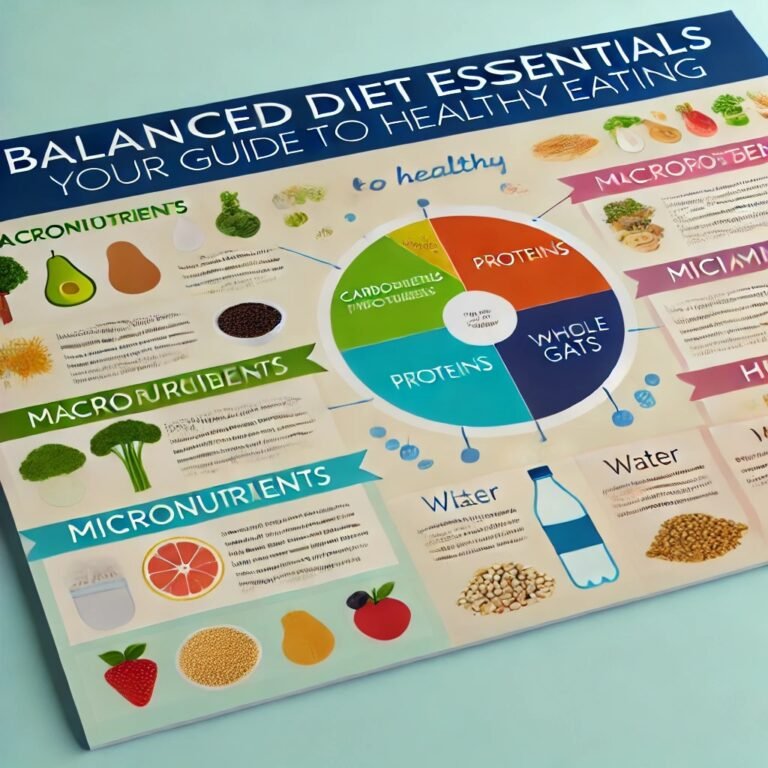
4 Comments
Comments are closed.